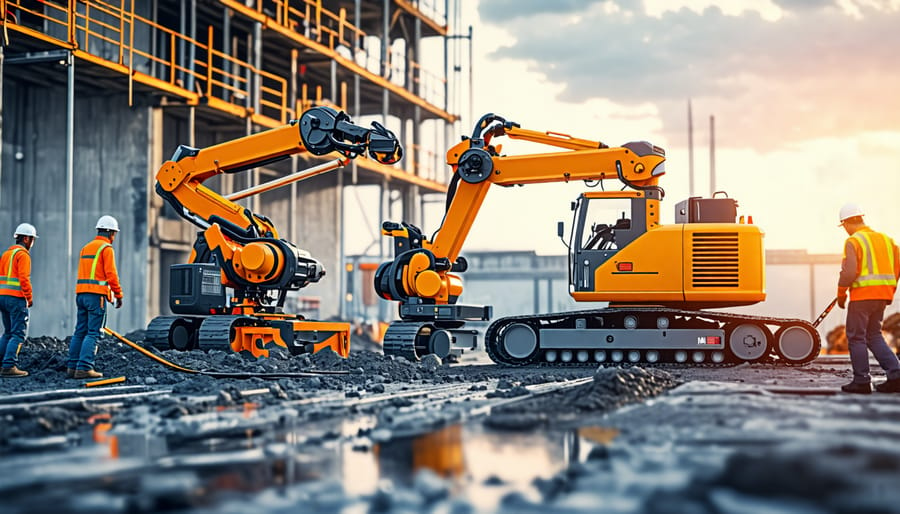Embrace Building Information Modeling (BIM) to streamline project planning and execution, reducing errors and enhancing collaboration among stakeholders. Adopt drones for site surveys and inspections to improve accuracy and efficiency, facilitating real-time data collection for informed decision-making. Leverage prefabrication and modular construction techniques to cut construction timelines, while boosting quality control and reducing waste. Implement advanced project management software to optimize resource allocation, ensuring projects are on time and within budget. Prioritize the integration of IoT devices on job sites for monitoring and maintaining safety standards, minimizing risks, and promoting worker welfare.
Emerging Technologies in Construction
The Rise of Robotics and Automation
Robotics and automation are at the forefront of futuristic construction innovations, revolutionizing how work is performed on construction sites. These technologies are driving efficiency by streamlining processes and minimizing human error while enhancing safety standards. Automated machinery such as robotic bricklayers and drones equipped for site surveillance are reducing labor-intensive tasks and allowing for precision in execution, resulting in significant time and cost savings. According to industry experts, the integration of autonomous vehicles for material transport and robotic equipment for hazardous tasks is rapidly advancing. This shift not only mitigates risks associated with human labor in dangerous environments but also addresses skilled labor shortages. Case studies across leading firms demonstrate that robotic exoskeletons are now crucial in aiding workers with heavy lifting, reducing musculoskeletal injuries. As these technologies continue to develop, they promise to transform traditional construction practices into safer, more efficient operations, setting new standards for the industry.

3D Printing: A New Age of Construction
3D printing is revolutionizing the construction industry by fundamentally transforming building processes and materials. This innovative technology enables the creation of complex structures with unprecedented precision and efficiency. By using 3D printing, architects and engineers can design bespoke architectural elements and entire buildings with reduced waste and lower labor costs. The ability to use various materials, such as concrete, polymers, and metals, opens up new possibilities for sustainable construction practices. Expert interviews highlight case studies where 3D-printed structures have demonstrated enhanced durability and aesthetic flexibility, suggesting a promising future for this technology in mainstream construction. Furthermore, 3D printing facilitates on-demand construction, significantly reducing lead times and resource consumption. As the technology evolves, it offers industry decision-makers a scalable and sustainable solution that can address the growing demands for faster and more environmentally friendly construction methods. Embracing this trend not only boosts innovation but also positions companies at the forefront of a new age in construction.

Drones for Surveying and Monitoring
In the construction industry, drones are revolutionizing surveying and monitoring by enhancing precision and facilitating real-time data capture. Equipped with high-resolution cameras and LiDAR technology, drones deliver detailed aerial images and 3D models, crucial for accurate topographical assessments. This capability significantly reduces the time and labor traditionally required for surveying, allowing for more frequent data capture and informed decision-making.
Beyond just surveying, drones are pivotal in monitoring construction progress and site safety. They enable project managers and engineers to conduct site inspections remotely, identifying potential issues early and ensuring compliance with safety protocols without the need to physically navigate hazardous environments. Such real-time monitoring not only improves operational efficiency but also mitigates risks, ultimately enhancing overall project management.
The integration of drones into construction projects exemplifies a shift towards digital transformation, promoting a data-driven approach to building and infrastructure development. As technology advances, drones will undoubtedly play an increasingly vital role in reshaping industry standards, offering unparalleled precision and safety in construction workflows.
Sustainable and Energy-Efficient Technologies
Green Building Materials
In the forefront of construction industry technology trends, eco-friendly building materials are transforming the landscape by prioritizing sustainability without compromising quality. Innovations such as cross-laminated timber (CLT) and bio-based materials like mycelium and hempcrete demonstrate a commitment to reducing environmental impact. CLT, known for its structural strength and versatility, offers a renewable alternative to traditional materials, aiding in carbon sequestration and reducing waste. Mycelium provides an organic solution with its excellent insulation properties and biodegradability, while hempcrete, made from hemp fibers and lime, enhances thermal insulation and breathability in buildings.
These materials not only contribute to energy efficiency but also promote healthier indoor environments by reducing volatile organic compounds (VOCs) commonly found in conventional options. As construction professionals increasingly recognize the importance of sustainable practices, these innovative materials offer compelling ecological and economic benefits, paving the way for a greener, more resilient future in the construction sector. Embracing these advancements aligns with both ethical imperatives and market demands, highlighting a pivotal shift toward sustainability in building practices.
Smart Energy Systems
In the evolving landscape of construction, smart energy systems are pivotal. Technologies such as smart grids enhance energy distribution, providing real-time data that allows for efficient energy management across construction sites. These grids facilitate the integration of renewable energy sources, reducing dependency on fossil fuels and promoting sustainability. An exemplary feature of smart energy systems is the deployment of energy-efficient HVAC systems. Utilizing advanced sensors and AI algorithms, these systems optimize temperature regulation and minimize energy wastage, supporting environmentally friendly construction practices.
Moreover, these innovations align with industry standards and offer significant cost-saving opportunities for projects of varying scales. As project managers and engineers seek to future-proof their builds, leveraging smart energy systems and energy-efficient home techniques becomes imperative. These technologies not only enhance operational efficiency but also elevate the project’s compliance with emerging energy codes, ultimately reshaping sustainable construction practices.
Case Study: Sustainable Building Projects
In recent years, sustainable building projects have set benchmarks in the construction industry by effectively integrating innovative technologies with eco-friendly practices. A prime example is the Bullitt Center in Seattle, often lauded as the greenest commercial building in the world. This project utilized solar panels, geothermal heating, and a rainwater capture system to achieve zero net energy consumption. Such performance is bolstered by a data-driven approach to energy management, which is a critical component for sustainable building management. Another noteworthy case is the Bosco Verticale in Milan, which stands as a testament to urban biodiversity through its vertical forest architecture. This project not only enhances air quality but also demonstrates how integrating nature into urban structures can contribute significantly to environmental sustainability. These examples highlight how thoughtful design and advanced technology can lead to more sustainable and resilient urban environments, offering valuable insights for architects, engineers, and decision-makers within the construction industry.
Advanced Construction Management Software
BIM and Beyond
Building Information Modeling (BIM) continues to evolve beyond its traditional role of detailed design and planning, catalyzing a digital transformation across the construction industry. As BIM technology advances, it is increasingly integrated into every phase of the construction lifecycle, providing enhanced visualization and collaboration among stakeholders. Experts note that BIM’s expanded applications are revolutionizing project management by offering real-time data analytics, which improves decision-making and increases efficiency on complex projects.
Furthermore, BIM is now pivotal in promoting sustainability. By simulating building performance, BIM helps architects and engineers optimize energy efficiency and reduce environmental impact. The integration of BIM with emerging technologies like the Internet of Things (IoT) facilitates smart building management, offering insights into operational efficiencies and predictive maintenance.
Case studies in digital transformation demonstrate BIM’s capability in reducing project costs and timelines while enhancing quality. As the construction industry embraces these changes, staying informed on BIM’s latest advancements is crucial for professionals aiming to leverage its full potential.
Integrated Project Management Platforms
In the rapidly evolving construction industry, integrated project management platforms are proving indispensable for seamless project execution. These sophisticated platforms unify various project facets—design, scheduling, budgeting, and execution—into a single, coherent system. By doing so, they enhance communication, boost efficiency, and minimize errors that typically arise from fragmented management approaches. For architects, engineers, and project managers, the transparency and real-time updates provided by these platforms facilitate informed decision-making and swift issue resolution. Expert interviews and case studies reveal that integrated platforms significantly decrease project timelines, resulting in substantial cost savings. Moreover, they provide a centralized repository for all project data, ensuring compliance and simplifying audits. As construction projects grow in complexity and scale, these platforms are becoming essential tools for industry professionals seeking to maintain competitive advantage. Leveraging integrated project management tools not only streamlines operations but also supports sustainability initiatives by optimizing resource allocation and reducing waste.
Innovative Safety Technologies
Wearable Tech for Worker Safety
Wearable technology is reshaping worker safety in the construction industry by offering real-time monitoring and preventive measures. These devices, such as smart helmets, safety vests with GPS tracking, and biometric sensors, are designed to detect potential hazards before they result in accidents, thus enhancing site safety. For instance, smart helmets equipped with augmented reality (AR) provide workers with hands-free information access, overlaying critical data directly onto their field of vision, while biometric sensors monitor vital signs to preemptively identify signs of fatigue or stress-related conditions. These innovations enable project managers to track worker locations and health, allowing rapid response to emergencies and enhanced efficiency in managing large sites. Furthermore, data collected from wearables can be analyzed to improve safety protocols and training programs based on actual incidents and near-misses. Embracing these advancements not only enhances safety but also boosts productivity by ensuring a more secure and health-conscious work environment.

AI-Powered Safety Solutions
Artificial intelligence is transforming safety measures within the construction industry, offering unprecedented abilities to predict and prevent potential incidents. AI systems analyze vast datasets, including historical accident reports and real-time site data, to identify patterns that may lead to safety hazards. For instance, machine learning algorithms can anticipate risks such as equipment malfunctions or human error by continuously monitoring variables like weather conditions, equipment status, and worker behavior. A noteworthy case is the use of AI-powered wearable devices that track workers’ movements and environmental conditions, alerting them to take corrective actions to avoid accidents. Industry leaders, like Skanska, have successfully integrated AI tools with their safety protocols, resulting in significant reductions in on-site incidents. Experts highlight that the collaboration with AI not only enhances immediate safety outcomes but also fosters a culture of proactive risk management. As firms increasingly adopt these technologies, AI’s role in construction safety is poised to grow, fundamentally altering how sites manage and mitigate risks.
Conclusion
In conclusion, the integration of undefined technologies in the construction industry represents a transformative shift with promising potential. This article has highlighted key tools and methodologies emerging in the field, including advancements in project management systems, the implementation of sustainable materials, and cutting-edge safety innovations. Through expert interviews and in-depth case studies, we’ve seen how these technologies are not only improving efficiency and quality but also driving significant cost reductions and environmental benefits. Looking forward, the continued evolution of these technologies could redefine industry standards, offering even more sophisticated solutions for complex construction challenges. As technology progresses, it is crucial for construction professionals, decision-makers, and project managers to stay informed and adaptable, ensuring that they harness these innovations to improve outcomes and maintain a competitive edge. By embracing the future potential of construction technologies, the industry is well-positioned to achieve unprecedented levels of productivity and sustainability.

